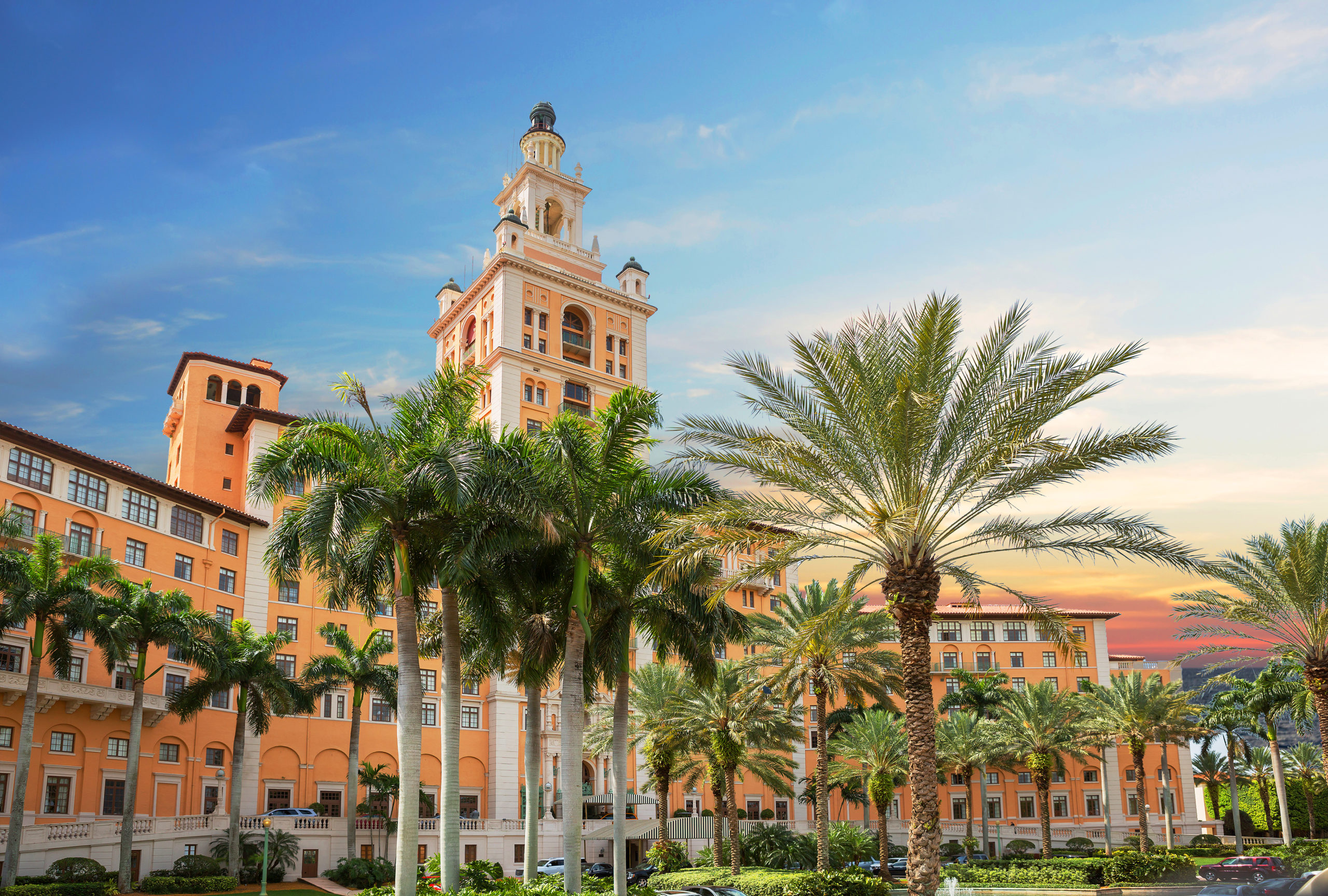The city of Coral Gables was one of the first planned communities in the United States, developed primarily by George Merrick in the 1920s as the region was first booming. Merrick did a superb job designing the city, creating unique zones and architectural landmarks that still make Coral Gables a prime residential destination today.
Spanish and Mediterranean Style
Originally, the plan was to design Coral Gables using solely Spanish and Mediterranean architectural styles. This design focus still predominates in Coral Gables, and you’ll notice Spanish Renaissance, Spanish Colonial, Italian Renaissance, and Arabic Andalusian elements in the buildings there, with touches of French Colonial and Venetian Gothic too.
Buildings in these styles are solid and substantial, usually with symmetrical facades and other hallmarks, such as:
- Stuccoed walls
- Red tiled roofs
- Arched windows
- Wrought iron ornamentation
- Elaborate door surrounds
- Courtyards with gardens
- Fountains
The Biltmore Hotel in Coral Gables is a fantastic example of Merrick’s vision, designed by the Schultze & Weaver architectural firm of New York City. The success of Merrick’s plan even drew admiration from King Alfonso XIII of Spain, who awarded him the Order of Isabella the Catholic for promoting Spanish culture.
Merrick’s Seven Villages
George Merrick wasn’t content to only develop Coral Gables in the Spanish and Mediterranean styles. He wanted to play with other architectural styles as well and so created a series of “villages” scattered around the city. While he never completed his Persian, Moorish, English, or Swedish villages, seven others exist today.
Chinese Village
This village, which occupies the 5100 blocks of Riviera Drive and Menendez, Castania, Maggiore, and Sansovino Avenues, is made up of eight residences in the Chinese Compound style and were designed by Henry Killam Murphy in 1926. Full of bright, primary colors, they feature high walls and decorative gates, which were key components of Chinese architecture for affluent people of the time.
Pioneer Village
Adjoining the Riviera Golf Course, Pioneer Village mixes Greek revival design with early American architecture. You’ll see tall pillars, stately porticoes, huge second-story balconies, and white picket fences in this neighborhood.
Italian Village
Frank Wyatt Woods designed this village along Monserrat, Palmarito, and Altara Avenues in 1926. It harks back to the 17th- century villas of Italy, with its walled gardens, exterior staircases, and entrances fronting the street.
French City Village
The 1000 block of Hardee Road is home to the French City Village, designed to look like French town homes of the 18th century. The north side of the road was designed by Mott B. Schmidt, while the south side was created by Philip Goodwin. Owners of these properties appreciate their French doors, ornate details, open porches, and courtyards.
French Country Village
Inspired by French estates and chateaux of the 18th century, Philip Goodwin also designed part of this village, along with Frank Forster and Edgar Albright. Offering enormous backyards, these homes are notable for their round towers, wrought-iron balconies, red brick, keystone accents, and carved wood details.
French Normandy Village
This style was popular in 15th-century England and France. Merrick’s version, on LeJeune Road and the 400 block of Vizcaya Avenue, was designed by John and Coulton Skinner. Timber beams support stucco walls in what were once both 1930s men’s dormitories and World War II barracks.
Dutch South African Village
Marion Syms Wyeth of Palm Beach designed these homes on LeJeune Road, Riviera Drive, and Maya Street, which resemble houses Dutch colonists inhabited in South Africa. Shaped to resemble the letters “L” or “U,” as was the style then, they showcase walled gardens, steep roofs, and high arches, as well as classic scrollwork above the doors and windows.
Coral Gables in 2022
The city of Coral Gables today has held onto its reputation as a highly desirable, manicured community with an abundance of charm. You’ll find tall palm trees along the streets, velvety green lawns and golf courses, and dozens of lush parks and bridges that give the city a one-of-a-kind feel. While luxury condos have sprung up since Merrick’s day, there remain many stunning single-family homes and estates, including waterfront properties, which provide homeowners with the perfect mix of historic appeal and modern conveniences.
When you’re ready to explore Coral Gables to find the ideal property, I welcome the opportunity to meet with you. Feel free to call me at 786-667-9078 or email me at Debby@DebbyNilsson.com. You can also use the message form on my Contact page to let me know how I can assist you.





